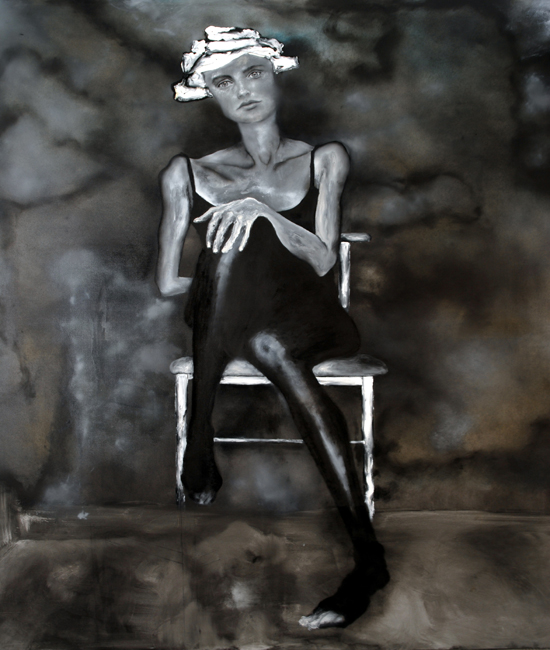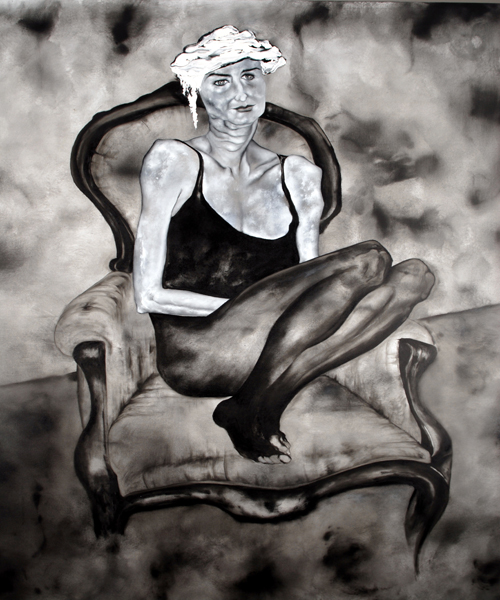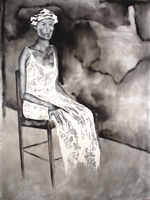TIME AND MEMORY
by Cristina Trivellin
I’ve come from the brightness and I return to the brightness...”
A phrase written between sketches, drawings and citations on the door of an old fridge which transformed itself into his creative support, located in the corner of Pedro Fiol’s studio. This starts us on our trail into the world of this Cuban born, Milanese artist. An ironic, surreal and prophetic phrase; the circle appears to be already closed but in reality, he is in between these two bright places, developing his artistic course; a course which probes humanity and our very existence, congealed with dense paints that are contaminated by his strong personality.
As a child, Pedro held within him the “drawing demon”, an impressive technical skill which manifested itself prematurely in his beautiful drawings which he still keeps hidden and conserved in his studio. He rarely attended art school as he was a restless soul who preferred to acquire his artistic knowledge through his life experiences. His journey began in Cuba, continued through his travels in Europe and finished when he chose to settle in Italy. When studying his work, you don’t see the well known, traditional Cuban style, which still carries with it the tell-tale signs of Picasso’s teachings from the avant-garde era of 900. Pedro Fiol is an expressionist of our time, who lives for today, is an admirer of Francis Bacon and of European Figurative-expressionism. He is devoted to disenchantment and existentialist reflection and this comes through in his use of sulphuric, acidic yellow and grey colours that only sometimes leave room for carmine reds and the odd note of Caribbean colours.
In undertaking a journey through the work of Pedro Fiol, you encounter a humanity that will take your breath away: present absence, absent presence, fading, floating figures, gazing directly into another world, I think of hermaphrodites and their alien bodies, immersed in material and sign language, the challenge of time, an avid reader of meaning, drop by drop, in exchange for blood and sweat. They are bodies which are symbolic of the necessity of encountering your soul mate and only when you encounter your other half can you hinder unequalled incommunicableness between humans, between men and women and among the living. Now we look at his series of work entitled “Dostoevskji and I”: a homage to the famous Russian and all his work. Five canvases, five numbered rooms, five characters in search of senses...closed in a crooked birdcage and without the possibility of escape because, amongst other reasons, of the size of their bodies. Still gazing out into the unknown with the proud gaze of someone who contemplates and accepts the beginning and the end. It appears to me that the artist wholeheartedly welcomes this phrase, written by the celebrated Russian writer in a letter in 1869: “I’ve got my own way of looking at reality (in art), what the majority of people call fantastic and exceptional, at times I see as what constitutes the true essence of reality.” It’s obvious that Pedro Fiol has absolute faith and loyalty in reality.
The journey continues, not chronologically or rationally, through another important series; ‘The Gladiator’. In this series we see more references to the style of Francis Bacon, we see seated men who, although have not been given eyes, appear to captivate you with their gaze. The blind man who can see, the prophet with an imperfect, fleeting body, red like live meat and at the same time a ghost who watches, without nostalgia, the dimensions he has recently abandoned. This loss never shows in Pedro Fiol’s work, on the contrary, it’s a constant dimension that is part of the iconographic repertoire, represented by what is lacking or unfinished in each painting. ‘Perfection does not come from paint’, affirms the artist. We now move to the ‘moments’ series that comes from Cuba to tell us what the protagonist does on a daily basis. The artist has spent time with his subject to paint his life moments. It is the story of any existential 40 year old man that bears the signs on his body of having had a hard, useless life, a round stomach, wrinkled skin but with the gaze of someone who knows something but doesn’t quite understand it. Life, made up of small, insignificant gestures, painted in grey tones by a Cuban, with nothing heroic but the acceptance of his fleeting nature and insignificance. In this way, the artist puts emphasis on human dignity, electing his subject and giving him a bit of continuity. Survival through art of someone who hasn’t done anything worth remembering but the most important thing is to have lived.
We have arrived at the end of our brief but intense journey, we are confronted with an artist that relentlessly searches for, through his art, a way to free himself with a disenchantment that makes you watch from a distance that never touches on cynicism, to enable himself to emerge without fear and express what can and can’t be said. Pedro Fiol talks about pain but doesn’t fuel it; he lives it and gets over it. Paint, art, lived like a catharsis, a way out, Pedro writes: “An equilibrium between my unease and my work, the highest point of my person coincides with the highest point of quality of my canvas.”
In the direction of brightness.



.jpg)
.jpg)